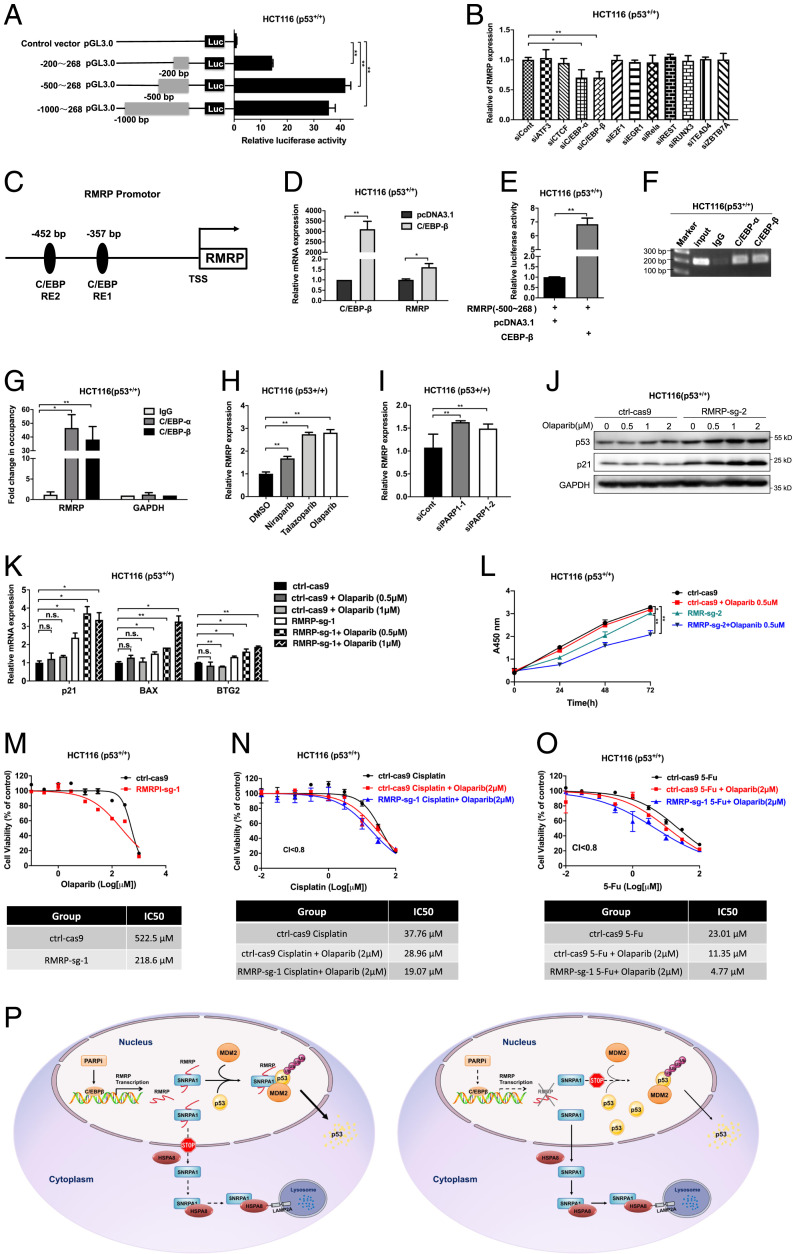Fig. 7.
The C/EBPβ-RMRP axis confers colorectal cancer resistance to PARP inhibition. (A) Evaluation of the RMRP promoter activity by the luciferase reporter assay. (B) RMRP expression was determined by individually knocking down 11 TFs in HCT116 p53+/+ cells. (C) Schematic of the ∼500-bp region of the RMRP promoter. Two potential consensus binding sites of C/EBPs are indicated. (D) Overexpression of C/EBPβ up-regulates the RMRP level in HCT116 p53+/+ cells. (E) Overexpression of C/EBPβ triggers RMRP promoter (∼500 bp) activity as determined by the luciferase reporter assay. (F and G) C/EBPα and β associate with the RMRP promoter by the ChIP assay. The bound DNA elements were analyzed by PCR. (H) The expression of RMRP was induced by PARP inhibitors, including Olaparib, Niraparib, and Talazoparib. HCT116 p53+/+ cells were treated with the PARP inhibitors for 16 h before harvested for RT-qPCR. (I) Knockdown of PARP-1 up-regulates the RMRP level in HCT116 p53+/+ determined by RT-qPCR. (J and K) Knockout of RMRP sensitizes cancer cells to Olaparib-induced p53 activation. (L) A low dose of Olaparib significantly inhibits proliferation of RMRP-knockout, but not RMRP-proficient, colorectal cancer cells. (M) Knockout of RMRP sensitizes colorectal cancer cells to Olaparib as determined by the IC50. (N and O) Knockout of RMRP sensitizes colorectal cancer cells to the combination use of Olaparib with the genotoxic agents, Cisplatin (N) and 5-FU (O), as determined by the IC50. *P < 0.05, **P < 0.01 by two-tailed Student’s t test. (P) A schematic for RMRP-induced colorectal cancer resistance to PARP inhibitors by preventing p53 activation. Treatment of cancer cells with PARP inhibitors induces RMRP expression through the TF C/EBPβ. RMRP interacts with and sequesters SNRPA1 in the nucleus, thus blocking CMA-mediated lysosomal proteolysis of SNRPA1. The nuclear SNRPA1 then binds to p53 and promotes MDM2-induced p53 ubiquitination and proteasomal degradation (Left). Knockout of RMRP prompts cytosolic enrichment and lysosomal degradation of SNRPA1, leading to reactivation of p53 and tumor cell sensitization to PARP inhibitors (Right).

